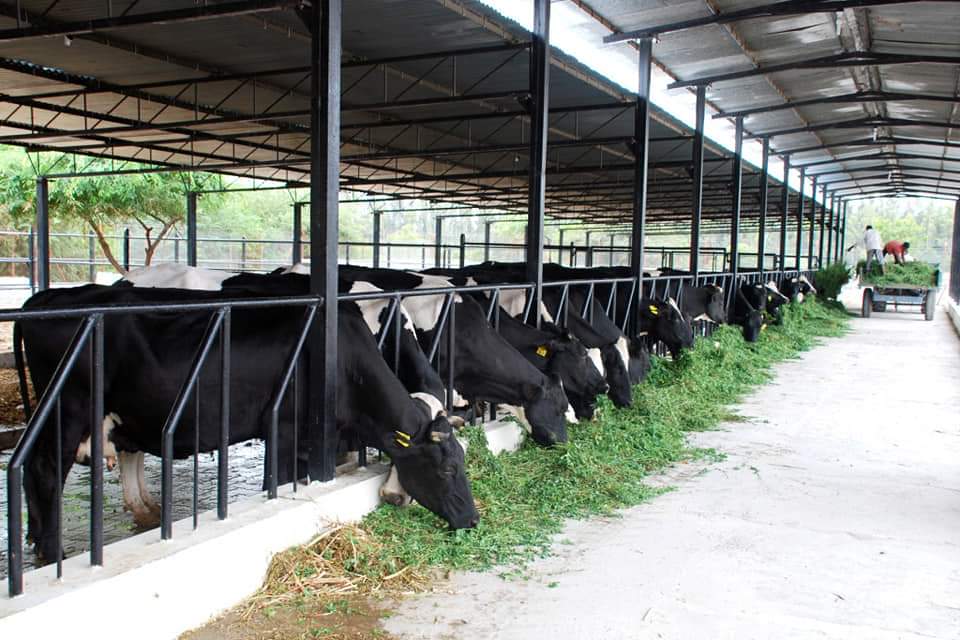Feeding Strategies of High Yielding Dairy Animals
Vipin
Ph.D. Scholar
Division of Animal Nutrition, ICAR-National Dairy Research Institute
Introduction
Milk production per cow continues to extend 2-3% annually. Genetic improvement accounts for 33 – 40 % of this increase while feeding and management contribute the remaining 60 to 67 per cent. In the paper, emphasis will be on a critical time in the lactation and gestation cycle: 60 days prepartum (dry period) to 60 days postpartum (fresh cow period).
Problems during the Periparturient Period
The following problems observed during the transition period in high yielding dairy animals.
- Dry matter intake after calving is low and unsatisfactory.
- Cases of off feed are too high, especially in young cows.
- Fresh cows do not take off the feeds.
- Metabolic disorders are fatty liver, ketosis, milk fever, hypocalcemia, and/or displaced abomasum.
Feeding approaches before calving
The transition ration should provide the proper amount of nutrient for the pregnant dry cow and her unborn calf (for example pounds of protein, grams of calcium, milligrams of selenium, and units of vitamin E). The following care should be considered when formulating the transition diet.
- Dry matter intake declines dramatically five days before calving.
- During the dry period, cows receive a forage-based ration which causes the rumen papillae (small fingerlike projections on the rumen wall) to shorten. When cows receive rations higher in fermentable carbohydrate (grain), the papillae elongate to increasing the surface area of the rumen, absorbing more volatile fatty acids, and reducing the acid load in the rumen. The time for total elongation of papillae is 4 to 6 weeks.
- Rumen microbes must be shifted from primary fibre digesting to both fibre and starch digesting bacteria because of the diet fed early lactation cows.
- High yielder’s cows begin to develop fatty livers tendays before giving birth and continue till lactation. If a cow is healthy, liver fat levels decline.
- Feeding higher levels of vitamin E (1000 I.U. per day) in dry cows reported lower somatic cell counts and mastitis risk, higher blood levels of vitamin E in the unborn calf, and higher colostrum levels of vitamin E.
- Cow immunity is challenged at calving as the reproductive tract is open, mastitis infections rates are high, and hormonal changes are occurring. Adding micronutrients such as zinc, copper, and selenium may be beneficial along with vitamins.
- Hypocalcemia (total blood calcium <8 mg/dl) is a problem affecting 75 per cent of high producing cows. Low blood calcium can lead to the retained placenta, poor uterus involution, less smooth muscle contraction, and an increase in the displaced abomasum. Anionic salts can minimize hypocalcemic risk.
Application of feed additive
Niacin can be fed@ 6 grams per day. It can minimize ketosis risk. Propylene glycol can be drenched to dry cows one week before calving at the rate of 0.5 kg per day which can reduce fat liver formation, raise circulating blood glucose levels, and minimize ketosis risk. Anionic salts should be given@ 2 to 3 equivalents which bring the DCAD (dietary cation-anion difference) less than zero (-50 to -150 meq/kg). Dietary calcium levels should be increased to 150 to 180 grams of total calcium with a minimum of 50 grams from inorganic sources. Yeast culture can be added to stabilize the rumen environment and pH.
Feeding Approaches after calving
The first 60 days after calving (also referred to as the postpartum or fresh cow period) is critical to cow health and economic success of the total lactation. Fresh cows have several challenges that must be considered and controlled.
- Peak milk production typically occurs 50 to 60 days after calving setting the lactation curve.
- For every 1 kg of peak milk production, the lactation total increases 200 to 225 kg of milk.
- Maximum energy shortages occur in the first three weeks of the lactation.
- Ketosis occurs in one third to one-half of high producing cows which can lead to fatty liver syndrome if not controlled.
- Reproductively sound cows will have their first heat cycle 15 to 25 days after calving.
- Energy status in the first three weeks after calving affects the developing follicles 60 days later
Dry matter intake
Dry matter intake is reduced 18 per cent in early lactation. Nutrient concentrations should be adjusted for lower intake potential. Factors that can improve dry matter intake should be implemented.
- TMR will maximize dry matter intake in early lactation.
- Forage quality should exceed 1.32 M.cal.of net energy per kg of dry matter.
- Rumen digestion must be maximized by balancing degradable protein and carbohydrate (NFC) allowing higher microbial yields of volatile fatty acids, optimal rates of feed passage, and maximum microbial protein.
- Rumen pH and environment must be favourable for microbial performance and growth.
- Bunk management must provide free-choice feed, maintain palatable and fresh feed, and encourage cows to return frequently to eat, especially during the heat and cold stress conditions.
Application of feed additives
Niacin can feed @ 6 to 12 grams per day until maximum dry matter intake occurs (10 to 12 weeks postpartum). Buffers are additives that maintain rumen pH between 6- 6.3. Sodium bicarbonate and sodium sesquicarbonate are the most common commercial products fed at 120 to 250 grams per cow per day. A combination of 2 to 3 part bicarb to one part mag oxide is recommended. Propylene glycol is converted in the liver to glucose which can prevent ketosis and fatty liver formation. Yeast cultures and yeast products can stimulate fibre digesting bacteria, maintain rumen pH, and stimulate VFA production. The level of yeast cultures and products vary from 10 to 115 grams per cow per day.
Conclusion
Nutrition can have profound effects on all aspects of production, health and reproduction of animals. Negative energy balance must be minimised by controlling proper nutrition in late lactation and optimum nutrition at each stage of the lactation cycle significantly improves health and fertility.


